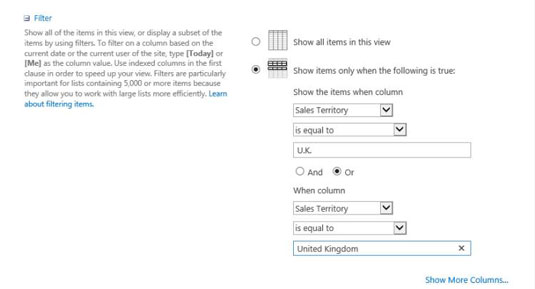You can use the filtering options of views in SharePoint to limit the items displayed. You can choose which columns to filter on and how to apply the filter. You can use filters to display app data where a certain column is equal to some value or not equal to some value, or where an item was created between certain date ranges.
You can create filters using columns that are based on String, Number, Currency, or Choice data types. However, you can’t filter on lookup columns or multiline text fields.
Building a filter in SharePoint is like writing an equation; for example, x > y. In this case, x is the column you want to filter on, and y is the value you want to test the column contents against. The operator in between determines what the test evaluates. This test gives the system a TRUE or FALSE response to your equation.
Available operators are
Equality: Is Equal To or Is Not Equal To
Comparison: Is Greater Than or Is Less Than
Substring: Contains or Begins With
The filtering equation is evaluated for each item in your app. If the equation is TRUE, the item is included in the view; if the equation is FALSE, the item is excluded.
If you don’t see the results you expect to see in your view, your filter is probably evaluating to FALSE.
For numerical values, you usually use the Equality or Comparison operators. When you create filtered views in SharePoint apps based on string (text) values, you want to be familiar with your data before trying to create the filter.
For example, if you want to filter a Contacts app to display only those contacts in the U.K., you have to ask how the value for the U.K. has been entered in the app. Is it U.K., United Kingdom, or both? You can use a Datasheet view to quickly scan the data to determine the range of possible values.
One way to get around this problem is by validating your data when it’s being entered. You can use Choice columns to do that or use SharePoint 2013’s validation features.
Say you discover that your data include both values — U.K. and United Kingdom. You could go through and make all the data consistent. Or you could filter for both values using the Or option.






